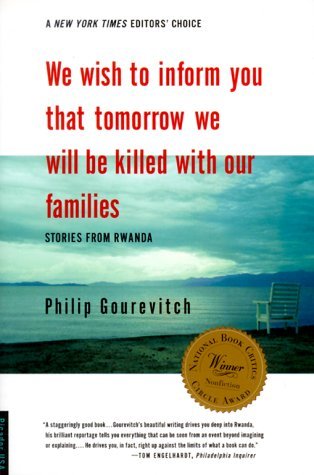Sins of Omission – by Bob Wood
Please go here to access Mr. Woods’ and Angelina’s Uganda / Rwanda 2015 Summer Travel series.
page 170 – Philip Gourevitch – “Listening to him (General Dallaire) I was reminded of a conversation I had with an American military intelligence officer who was having a supper of Jack Daniel’s and Coca-Cola at a Kigali bar.
“i hear you’re interested in genocide,” the American said. “Do you know what genocide is?”
I asked him to tell me.
“A cheese sandwich,” he said. “Write it down. Genocide is a cheese sandwich.”
I asked him how he figured that.
“What does anyone care about a cheese sandwich?” he said. “Genocide, genocide, genocide. Cheese sandwich, cheese sandwich, cheese sandwich. Who gives a shit? Crimes against humanity. Where’s humanity? Who’s humanity? You? Me? Did you see a crime committed against you? Hey, just a million Rwandans. Did you ever hear about the Genocide Convention?”
I said I had.
“That convention,” the American at the bar said, “makes a nice wrapping for a cheese sandwich.”
The West, Europe, the United States, me and you, where were we in 1994? What was our responsibility in the genocide? The world can be a very ugly place. And while the United States is not the cause of all the woes of this planet, we, like it or not, by virtue of our wealth, our democracy, our status, the sheer size of our bloated military, retain a vital role in addressing some of its most horrific crimes. In 1994 we fully vacated that responsibility. Somewhere near a million people were murdered, most of them by hand in acts, that with minimal Western military and political attention, and little risk to American servicemen, could’ve been avoided. But we didn’t act.
And since it is the citizenry that ultimately create public policy by pushing (or not) their democracy – that duty fell on me, on you, to do something. I didn’t call my Representative or Senator about Rwanda. I didn’t write a Letter to the Editor or take to the streets with a picket sign. I did nothing.
What did you do?
This book “We Wish to Inform you that Tomorrow we will be Killed with our Families” is a sobering reminder to all of the horrors of what happens when we vacate our responsibilities as human beings, watching out for other human beings. If you have been moved by any of my recent posts on the Rwandan genocide, or if your memory has been jogged, or maybe you just want to learn something about the dark places where humankind can land – read it. The book costs a penny used on Amazon.
Philip Gourevitch is a supremely talented journalist. He writes for the New Yorker. In 1995 he traveled to Rwanda. He talked to many involved in the killings; victims and perpetrators. He walked through the nave of the church in Nyamata and up the hill at Bisesero. He interviewed among others, Paul Ressesagabina of Hotel Rwanda. He captures the history of Rwanda, the oncoming inevitability and brutality of the genocide, and weaves a masterful story – ugly and true. And he writes with deepest distain for nations that sat on the sidelines and watched it all happen.
page 151 – Philip Gourevitch – “In May of 1994, I happened to be in Washington to visit the United States Holocaust Memorial Museum, an immensely popular tourist attraction adjacent to the National Mall. The ticket line formed two hours before opening time. Waiting amid the crowd, I tried to read a local newspaper. But I couldn’t get past a photograph on the front page: bodies swirling in water, dead bodies, bloated and colorless, bodies so numerous that they jammed against each other and clogged the stream. The caption explained that these were the corpses of genocide victims in Rwanda. Looking up from the paper, I saw a group of museum staffers arriving for work. On their maroon blazers, several wore the lapel button that sold for a dollar each in the museum shop, inscribed with the slogans “Remember” and “Never Again.” The museum was just a year old; at its inaugural ceremony, President Clinton had described it as “an investment in a secure future against whatever insanity lurks ahead.” Apparently, all he meant was that the victims of future exterminations could now die knowing that a shrine already existed in Washington where their suffering might be commemorated, but at the time, his meaning seemed to carry a bolder promise.”
One final note. Rwanda has a Genocide museum of its own, modeled in part after the United States Holocaust Museum. Angelina and I toured it while in Kigali. We were both extremely disappointed at what we found. I write about why, in my review for Trip Advisor linked here. For many reasons the museum comes up far short in addressing the issues, the crimes of commission and omission, perpetrated by Rwandans, Europeans, and Americans, that lie at the heart of the mass murder that was perpetrated in the Spring of 1994.
Never forget. Never Forget. I am weary of watching the world go to hell while we just keep repeating the same tired slogan, and do so little to change things.

















































































































